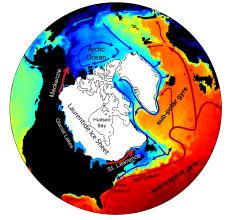NERSC Supercomputers Help Explain the Last Big Freeze
January 31, 2013
Contact: Linda Vu, lvu@lbl.gov, +1 510 495 240

This image shows the different routes that the meltwater could have taken to the ocean. (A. Condron, U. Mass, Amherst.)
Scientists suspect that about 13,000 years ago, a catastrophic injection of freshwater into the North Atlantic “conveyor,” which transports warm tropical water northward, triggered a major cold spell—known as the Younger Dryas or Big Freeze. But until recently, nobody could fully explain how the freshwater got there.
Using supercomputers at the Department of Energy’s National Energy Research Scientific Computing Center (NERSC), two researchers may have finally solved this mystery with unprecedentedly detailed simulations. Their results indicate that melting glaciers sent torrents of freshwater through Canada’s Mackenzie Valley into the Arctic, where ocean currents would have transported it to the North Atlantic (near Greenland), allowing it to disrupt the ocean’s heat engine.
“With 18 kilometers between each grid-point, we have the highest resolution ocean model in paleoclimate. With this much detail, we can accurately follow the pathways that meltwater travels to the ocean, track the ocean currents and see where the freshwater mixes with saltwater,” says Alan Condron, a physical oceanographer at the University of Massachusetts, Amherst.
Condron and his colleague Peter Winsor of the University of Alaska Fairbanks, are coauthors of a paper published in the December 2012 issue of Proceedings of the National Academy of Sciences.
Simulations Sift Out Truth in Competing Views
Geologists classify the Younger Dryas as a “stadial,” or a relatively brief (1,200-year-long) cold spell that interrupted a warm period between ice ages. During the last warm period, a massive ice sheet covering most of Canada was melting. Many researchers suspected that meltwater from this sheet interrupted the North Atlantic conveyor, but until the recent simulations they could not explain how.

This zoomed-in image shows ocean temperatures in the Northwest Atlantic. Red colors are warm and blue is cold. (A. Condron, U.Mass, Amherst)
Some scientists suspected that the Younger Dryas was caused by an abrupt overflow of Lake Agassiz, a colossal pool of metlwater along the southern edge of Canada’s ice sheet. In this scenario, the overflow would have streamed through the Great Lakes and St. Lawrence Valley to the Atlantic, where it would have shut down the conveyor belt, causing global temperatures to plummet.
“We ran our models many times on NERSC’s Hopper system. We looked at how freshwater would travel to the North Atlantic if Lake Agassiz overflowed and all of the other scenarios that researchers have long considered, but none of these events were able to kickstart the Younger Dryas,” says Winsor.
The NERSC simulations showed that an overflow of meltwater from Lake Agassiz, which enters the North Atlantic via St. Lawrence, would have traveled south and met the Gulf Stream. In turn, this would have carried the freshwater about 3,000 kilometers too far south to interfere with the ocean’s conveyor belt. Winsor notes that such a flood would have slowed the ocean circulation and associated heat transport by 14 percent.
“We found that the arctic is the most sensitive place where you would have the confluence of events to kickoff the Younger Dryas,” says Winsor. He notes that a flood through the Mackenzie Valley—taken by currents to the subpolar North Atlantic—would have weakened the ocean’s conveyor belt by as much as 32 percent.
“To get 18 kilometer resolution for these models, we need quite a bit of processing power, and this is where NERSC’s computing resources have been invaluable,” says Condron, who has been computing at NERSC since 2009.
Condron notes that the team hopes to eventually get their model to resolve the ocean at 4 kilometers, so they can see iceberg trajectories. The Department of Energy’s Office of Biological and Environmental Research, within the Office of Science, supports this work.
About Computing Sciences at Berkeley Lab
High performance computing plays a critical role in scientific discovery. Researchers increasingly rely on advances in computer science, mathematics, computational science, data science, and large-scale computing and networking to increase our understanding of ourselves, our planet, and our universe. Berkeley Lab’s Computing Sciences Area researches, develops, and deploys new foundations, tools, and technologies to meet these needs and to advance research across a broad range of scientific disciplines.







 Instagram
Instagram YouTube
YouTube